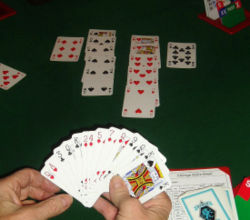Bridge tournaments
|
Bridge declarer play
|
|
| Alternative names | Bridge |
|---|---|
| Type | Trick-taking |
| Players | 4 |
| Skills required | Memory, , probability, communication |
| Cards | 52 |
| Deck | French |
| Play | Clockwise |
| Card rank (highest to lowest) | A K Q J 10 9 8 7 6 5 4 3 2 |
| Playing time | WBF tournament games = 7.5 minutes per deal |
| Random chance | Very Low |
| Related games | |
| Whist, Auction bridge, Contract bridge | |
Duplicate bridge is the most widely used variation of contract bridge in club and tournament play. It is called duplicate because the same bridge deal (i.e. the specific arrangement of the 52 cards into the four hands) is played at each table and scoring is based on relative performance. In this way, every hand, whether strong or weak, is played in competition with others playing the identical cards, and the element of skill is heightened while that of chance is reduced. Duplicate bridge stands in contrast to rubber bridge where each hand is freshly dealt and where scores may be more affected by chance in the short run.
Bridge boards, simple four-way card holders, are used to enable each player's hand to be passed intact to the next table that must play the deal, and final scores are calculated by comparing each pair's result with others who played the same hand. Bidding boxes are often used to facilitate the mechanics of bidding, prevent inadvertent passing of information, and minimize the noise level. Screens are used in higher levels of competition and were introduced to reduce the chance of passing unauthorised information to one's partner.
In duplicate bridge, a player normally plays with the same partner throughout an event. The two are known as a "pair". There are two exceptions: in team events with up to six members swapping partners for portions of the event, and in individual tournaments, in which players change partners for each round.
The origins of duplicate bridge are based on the emergence of duplicate whist in the game of whist. In the introduction to his book Duplicate Whist, the author comments on the early emergence of duplicate whist:
The writer has it on good authority that it was played in Berlin and Paris as far back as 1840, and later in Philadelphia and New York...
Mitchell also recounts the Cavendish experiment of 1857 to demonstrate the merits of duplicate whist in reducing the element of luck and to distinguish between the skill levels of better and poorer players. Cavendish concludes:
...that this experiment does not altogether eliminate luck, as bad play sometimes succeeds. But by far the greater part of luck, namely, that due to the superiority of winning cards, is by the plan described quite got rid of.
Initially, owing to the early clumsy mechanics of card resorting to reconstruct the hands of a just played deal, the problems resulting from errors made in the transferring of cards between tables, and the unaccustomed movement of players between tables and the resultant slower pace of play, duplicate whist did not gain instant popularity. Nevertheless, the evolution of duplicate whist continued and the procedures and apparatus (known as trays or now, more commonly, boards) for more conveniently maintaining and transferring the cards of each deal for replay had been greatly improved so that by the 1890s duplicate's popularity had become widespread. In turn, as the game of whist was superseded by contract bridge, so was duplicate whist by duplicate bridge.
...
Wikipedia

